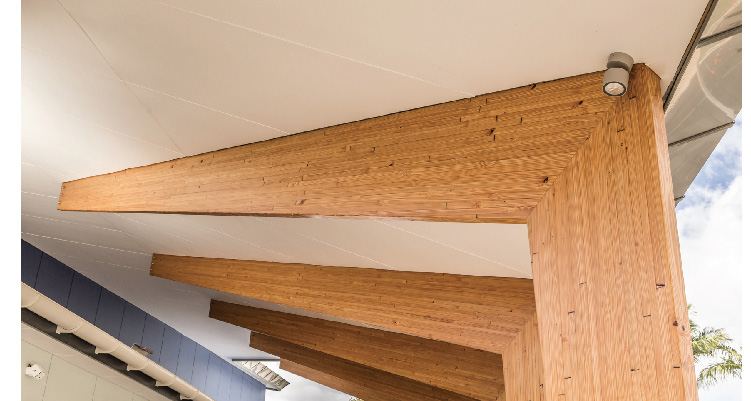
What better way to showcase the many qualities of engineered timber, including fire compliance in contemporary building design than a new Fire Station? Source: Timberbiz
This was the view of Hyne Timber when a potential opportunity arose to give the Maryborough Fire and Emergency Service personnel a new, state-of-theart facility.
The existing facility, an iconic part of Maryborough’s history, requires a complete functional overhaul while aiming to restore and retain the 1950’s local heritage valued façade.
This challenge attracted the attention of Hyne Timber who, like the first ‘Maryborough Fire Brigade’ have significant history in the Maryborough region dating back to since 1882.
In addition to a large pine sawmill and head office located in Maryborough, Hyne Timber operates a glue laminating plant (Glulam / GLT), supplying engineered timber solutions to both the domestic and commercial market.
According to Hyne Timber’s Manager for Strategic Relations, Katie Fowden, the idea of Australia’s first contemporary, engineered timber fire station in Maryborough quickly gained wide spread support.
“From an idea initially mentioned during an innovation forum in Maryborough, every conversation since with various stakeholders including fire engineering experts has seen nothing but support and encouragement to drive this project forward,” Mrs Fowden said.
“There are so many sustainable, environmental, structural, aesthetic, safety, health and cost benefits to using timber products in contemporary construction which this project will help to further showcase.
“However, first and foremost, we have been given a unique and exciting opportunity to demonstrate we can deliver a state-of-the-art facility for the fire service and emergency personnel who are effectively, our client throughout this next stage of the proposal.
“This opportunity has been enabled by the Queensland Government’s Market-Led Proposal pathway to put forward innovative ideas for the greater good of the community.
“Our project team includes The University of Queensland who we have been a research partner with for five years. Without existing research partnerships such as this, innovative engineered timber solutions and our proposal wouldn’t be possible.”
XLam will produce the Cross Laminated Timber (CLT) components required for this project, subject to accepted design work and approval to proceed to Stage 3 (final design and construction), from Queensland grown and processed timber.
Hyne Timber’s engineered softwood products are exclusively sourced from plantation pine grown in Queensland and is one of the strongest species of pine in the world. There is no timber waste from the manufacturing process with a customer for all by-products.
The bark for example, is sold to a bark processer on the Sunshine Coast who in-turn process it into potting mix which is sold back to a plantation nursery for the next round of million’s of seedlings. This has been described by environmental group, Planet Ark as a ‘virtuous cycle’.
The Maryborough Fire Station project, being a public asset, is an opportunity for innovative, engineered timber construction solutions to be more broadly understood to increase the uptake of sustainable buildings into the future.
This project also provides a real case study for Construction Skills Queensland to ensure the future of construction training is relevant for the increasing demand for sustainable, naturally built environments.
Given Maryborough is colloquially known as the ‘Timber City’, there is no better location for this project to be centred, seeing years of research and collaboration coming to fruition.
It is also in accordance with the Fraser Coast Regional Council’s progressive Wood Encouragement Policy, the first Council in Queensland to introduce such a policy at the start of the year.
The broader timber industry and extensive value chain which employs thousands of people throughout regional areas can leverage and grow from increased demand for responsibly grown timber for sustainable construction solutions.
The next stage of the proposal could take up to 12 months to complete, engaging with a broad range of stakeholders and consultants in addition to ongoing innovation research support with the UQ Centre for Future Timber Structures.







